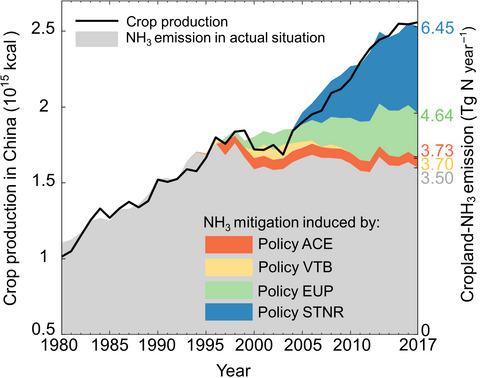当前位置:
X-MOL 学术
›
Glob. Change Biol.
›
论文详情
Our official English website, www.x-mol.net, welcomes your
feedback! (Note: you will need to create a separate account there.)
Decoupling between ammonia emission and crop production in China due to policy interventions
Global Change Biology ( IF 10.8 ) Pub Date : 2021-08-17 , DOI: 10.1111/gcb.15847 Wulahati Adalibieke 1 , Xiaoying Zhan 2 , Xiaoqing Cui 1 , Stefan Reis 3, 4 , Wilfried Winiwarter 5, 6 , Feng Zhou 1
Global Change Biology ( IF 10.8 ) Pub Date : 2021-08-17 , DOI: 10.1111/gcb.15847 Wulahati Adalibieke 1 , Xiaoying Zhan 2 , Xiaoqing Cui 1 , Stefan Reis 3, 4 , Wilfried Winiwarter 5, 6 , Feng Zhou 1
Affiliation

|
Cropland ammonia (NH3) emission is a critical driver triggering haze pollution. Many agricultural policies were enforced in past four decades to improve nitrogen (N) use efficiency while maintaining crop yield. Inadvertent reductions of NH3 emissions, which may be induced by such policies, are not well evaluated. Here, we quantify the China's cropland-NH3 emission change from 1980 to 2050 and its response to policy interventions, using a data-driven model and a survey-based dataset of the fertilization scheme. Cropland-NH3 emission in China doubled from 1.93 to 4.02 Tg NH3-N in period 1980–1996, and then decreased to 3.50 Tg NH3-N in 2017. The prevalence of four agricultural policies may avoid ~3.0 Tg NH3-N in 2017, mainly located in highly fertilized areas. Optimization of fertilizer management and food consumption could mitigate three-quarters of NH3 emission in 2050 and lower NH3 emission intensity (emission divided by crop production) close to the European Union and the United States. Our findings provide an evidence on the decoupling of cropland-NH3 from crop production in China and suggest the need to achieve cropland-NH3 mitigation while sustaining crop yields in other developing economies.
更新日期:2021-10-15











































 京公网安备 11010802027423号
京公网安备 11010802027423号